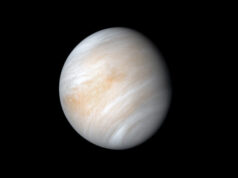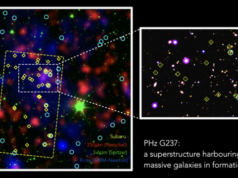SRON-astronomers have found the signature for aluminum oxide (AlO) in the spectrum of exoplanet WASP-43b. This came as a surprise because AlO is expected to stay hidden in the lower atmospheric layers. It is only the second time that astronomers have observed the molecule in an exoplanet’s atmosphere. The results are published in Astronomy & Astrophysics on July 1.
If you think planets like Mars or Jupiter are far away, try exoplanets. When you look up at the night sky and search for the closest exoplanet—an Earth-sized planet orbiting Proxima Centauri—you might as well look for the footprints on the moon. And that is only considering size; exoplanets are outshined by their host star about 1 billion times. So astronomers mostly use indirect observation methods to identify planets around other stars. They look for dips in the intensity of a star caused by a planet moving in front of it, or determine whether a star wobbles a bit due to a planet’s gravity. To examine the composition of an exoplanet’s atmosphere, astronomers measure its spectrum—the barcode imprinted in the starlight as the light passes through the atmosphere.
Astronomers from SRON Netherlands Institute for Space Research have now inferred the unexpected presence of alumunium oxide (AlO) in an exoplanet’s atmosphere. They examined exoplanet WASP-43b, a Jupiter-sized planet in close orbit around its host star WASP-43 at 284 lightyears from Earth. AlO would normally hide deep in the atmosphere, invisible to the infrared instrument of the Hubble Space Telescope used by the researchers. One logical explanation is that strong winds shake up the atmospheric layers.
“The presence of AlO in the region of the atmosphere we can analyze is very exciting, as it’s really unexpected,” says first author Katy Chubb. “It’s only the second time that anyone has seen some evidence of it in an exoplanet atmosphere. It is currently a mystery as to why we are seeing it, as it’s not expected at the temperatures and pressures of the region we are probing. We can speculate as to the reasons, which include the presence of strong turbulence dredging up gas from lower down in the atmosphere.”
Find your dream job in the space industry. Check our Space Job Board »
Future telescopes such as the James Webb Space Telescope and ARIEL—with contributions from SRON—will give astronomers more insight into warm giant exoplanets such as WASP-43b. It will help them to figure out if the presence of AlO is widespread, and therefore learn more about the dynamics and formation of these planets.
Provided by: SRON Netherlands Institute for Space Research
More information: Katy L. Chubb, Michiel Min, Yui Kawashima, Christiane Helling, and Ingo Waldmann. Aluminium oxide in the atmosphere of hot Jupiter WASP-43b. Astronomy & Astrophysic., arxiv.org/abs/2004.13679
Image: Artist’s impression of a Jupiter-sized exoplanet.
Credit: ESO/L.Calçada











